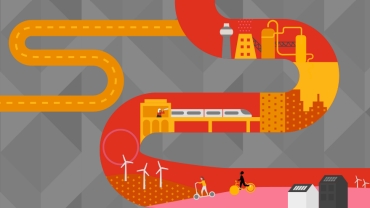
The power, utility and energy industry has a once-in-a-generation opportunity. Not only can it take a leading role in making its own cleaner energy future a reality, but it can help customers, communities and society accomplish this goal as well. Over the next decade, the lines will continue to blur among the industry’s traditional companies, emerging players offering new products and services as well as other adjacent industries, like transportation and manufacturing. Tomorrow will be more complex, less linear and more converged — looking nothing like today. At the same time, shifting policy, geopolitical uncertainties and technological advances will remain an undercurrent, shaping the path forward.
Industry leaders should bring into focus the role they want their companies to play in this new energy ecosystem, the path to get there and how to bring stakeholders along on the journey. The industry has the opportunity to be the author of its own energy transition story, rather than allowing others to define the narrative. Ahead, we explore what’s next for energy and utility companies.

Convergence of good intentions and muscle to make it happen
By committing to net zero goals and accelerating their environmental, social and governance (ESG) journey, many leading energy and utility companies are starting to define the positions they will take now and during the transition. Even those who first saw this as a passing storm to be weathered now see this as the opportunity that it is: An opportunity for the industry to reinvent itself — fundamentally changing the way it operates. This includes keeping the attributes that have served the industry well over its long history, while sunsetting what no longer serves a purpose in the energy ecosystem of the future.
It can be argued that no other industry is better positioned to do this. After all, the industry has more than 100 years of experience in meeting the needs of a growing and evolving society all while providing reliable, affordable and safe energy. Today’s industry players have several key differentiators on their side: expertise in engineering, infrastructure, science and energy markets, to name a few. When faced with a challenge the industry rallies — from creating technologies that can capture carbon or pinpoint energy sources miles underground to mounting massive efforts to restore power in the wake of extreme weather. What’s ahead is the rally of all rallies. It won’t be an easy task, but it’s one that the industry is well primed to shepherd through with decarbonization at the heart of strategy, supported by the right capabilities, technologies, business configurations and culture.

Balancing the promise of tomorrow with the responsibility of today
While the industry has the opportunity to lead the energy transition, it first needs to find a way to straddle bold ambitions for the future with very real, present-day obligations. Many are working to find the right footing in what can feel like paradoxical challenges or questions. Here are some of those top-of-mind questions, with many more weighing on today’s energy and utility leaders.
Deliver the energy needed to meet growing demand for net zero sources, when the bulk of energy still comes from hydrocarbons
Balance the intermittency of renewables with the need for reliability?
Embrace innovation without compromising reliability or safety?
Invest in new technologies while keeping prices down for customers?
Work with capital markets to deliver near-term profitability while creating long-term value?
Recycle capital, or find new purpose for assets that are still on the books, to avoid stranded assets?
Protect critical infrastructure from cybersecurity and other threats while introducing new technologies and connections into the grid?
Manage geopolitical dynamics and potential risks while balancing a desire for energy independence with continued cross-border interdependence?
Recruit or retain workers with the right skills for a cleaner energy future in one of the tightest labor markets?
Keep costs down while facing record-high inflation and ongoing supply chain uncertainty?
The ability to answer these questions certainly relies on external factors, like continued policy and regulatory support and cross-industry collaboration. Internally, it’s more important than ever to be able to prioritize, identify and act on effective drivers in the value creation ecosystem. This isn’t about trying to be all things to all people. It’s about doing the right things for the right reasons, and setting that as the North Star for strategy resulting in continued relevance in the new energy economy.
The strategic reinventor will find new ways to create value
We see strategic reinventors emerging as the leaders (and survivors) in the cleaner energy transition. This means those who can successfully reconfigure their portfolio, offerings and business model by either doubling down on efforts to become true integrated players in the energy ecosystem of tomorrow or finding attractive niches based on differentiated capabilities. Strategic reinvention can take several forms.
Energy platform players
Build connected energy ecosystems, while finding the interconnections across disparate assets and technologies.
Value chain specialists
Laser-focused value chain differentiation that hones in on areas of expertise.
Energy data brokers
Facilitate cross-industry exchange of energy or energy data including procurement/trading, verified carbon offsets and renewable credits
Energy as a Service
New services and solutions for improving energy consumption and outsourcing of energy supply or demand based on company or portfolio needs.
Strategic reinventors will need to put a stake in the ground as to who they want to be and then make it a relentless enterprise-wide goal to operationalize the vision. There are many paths forward that will likely include making strategic choices to build, acquire, divest portfolios and consider new business partnerships. Ultimately, success hinges on evolving the operating model of today to support the desired future state, shifting from incremental and demand-aligned investments to purpose-driven ones.
Key considerations for energy and utilities
Adaptability and agility are now THE core capabilities
Moving at the speed and scale needed for the cleaner energy transition requires both the adaptability to consider and respond to today’s challenges as well as the agility to to take swift and decisive action. To a large extent, the industry recognizes how critical this is to future success.
Adaptability and agility are needed across all areas of the business — from the cross-functional teams piloting new technologies and testing new practices to the tax functions nimbly leveraging local, provincial or federal incentives to help bring even more value to the business. Leaders must relentlessly prioritize the areas that can bring more enterprise-wide value with these rising to the top:
- Capital efficiency — Create innovative ways to recycle (repurpose) capital investments, pursue M&A to capture growth opportunities, leverage tax incentives for renewables and lower carbon solutions or use tax to unlock cash in business transformation.
- Beyond digital transformation — Start with your big challenge and build, buy or collaborate to create the differentiated capabilities and technologies around it.
- Enhanced experiences — Garner data-driven insights to rethink customer engagement and deliver new, seamless, exceptional experiences.
- NextGen assets — Leverage data to make informed decisions, optimizing the performance and health of physical assets and tracking progress toward carbon reduction targets.
- Regulatory — Nimbly navigate the changing regulatory environment to enable economic business cases and create pathways to sustained growth.
- Workforce — Employ strategies to attract and retain a workforce with the skills and agility to support the move to the cloud as well as the broader energy transition.

The great enabler of the energy transition
With adaptability and agility being crucial skills to bring to the table, emerging technologies — enabled through cloud — can help to bring innovation to life. A majority of energy and utility companies are counting on it.
We see the momentum continuing, with emerging technologies and cloud-based solutions playing a crucial role in enabling the energy transition at a lower cost and faster pace. This could include helping today’s transmission, distribution and storage infrastructure absorb new technologies and connections needed in the energy ecosystem of tomorrow. It could help others extract value from their existing investments in hydrocarbon technology, extending existing platforms to newer, cleaner energy assets. By embracing the cloud ecosystem as an incubator of innovation — and the fabric that connects everything — companies can accelerate progress, engage with customers in new ways and enable a quicker, more predictable evolution of our industry.
Having the right mindset: View “the cloud” as not a singular destination or a series of efforts, but as the connective tissue that enables broad business transformation. If you’re not planning ahead to adjust your operating model, your teams and create new ways of working, you could be off track.
Connecting the unconnected: Find the end-to-end interconnections that increasingly matter — from home EV charging or customer payment apps to your operations or infrastructure. Take a holistic view that helps you connect your people, customers, assets and information in new ways.
Focusing on outcomes: Prioritize and target business outcomes aligned to strategy, and then build what can help you achieve it. Prove the technology and solution can deliver value early in the process through rapid prototyping that allows you to make incremental improvements at the speed and scale needed. Even small wins advancing the business can build momentum quickly.
We see a future where energy and utility companies think of their technologies, processes and business outcomes as part of one connected platform that is flexible enough to scale and grow as the organization needs to evolve.

Evolving without losing sight of the culture that defines you
With today’s rapid pace of technology and the need to strategically reinvent the industry, it’s important for people to evolve along the same trajectory. Within a company’s current culture, there may be some long-established and unspoken codes or behaviors that seemingly work against the adaptability, agility and innovative mindset needed for the energy transition ahead. As an example, could utilities’ risk-averse and safety-first culture foster a reluctance to explore new ideas because of the risk they won’t pay off? What about the cultural implications of the boom or bust cyclical nature of the oil and gas industry? All valid questions. But, the converse is also possible. We believe that what the industry is known for can be harnessed and expanded, unleashing the positive aspects of existing culture to innovate through the energy transition.
We see leading companies succeed when they approach cultural evolution and innovation like this:
- Establish a clear vision and goals: Innovation and cultural change needs to be grounded in purpose. Create a common vision and success factors across the entire organization that go beyond financial goals and constraints. Make sure everyone knows what you are doing, why it’s important and the impact it can have on society.
- Define the behaviors that will contribute to the goals: These are behaviors that exist within your organization and if executed repeatedly by more people will move the habitual ways of working into better alignment with your organization’s strategic and operational objectives. As an example, one international oil company prioritized four critical behaviors and deployed them across a series of pilots leading to measurable business performance improvements that were directly attributable to the behavior change.
- Strive for quicker wins: Accelerate innovation through rapid prototyping and shorter testing cycles, making small shifts based on results. Many are doing this today by building EV charging infrastructure, blending lower carbon fuels, leveraging carbon management technologies and testing new ways to engage customers. But, to operationalize across the enterprise, this iterative mindset should be applied across every initiative: from back office transformation or tax strategy to workforce or asset management.
- Shift away from project-based mindset: Break away from people organized in functional silos and temporary project teams by adopting an approach where people are organized by value streams. The funding model should also shift from project to a portfolio — the overarching business outcome versus the technical implementations and other components that contribute to that outcome.
- Break down silos to assemble diverse teams: Move beyond titles, reporting lines and job descriptions to bring together whatever skills and experience are needed. Blurring the boundaries among functional teams — from operations, engineering and IT to finance, regulatory and customer — enables the team to jumpstart innovation and narrow the gap between what needs to be done (from a customer or operational perspective) and what can be done quickly (from a technology or regulatory standpoint).

The wave of opportunity
Fueled by growing interest and increasing clean energy investments, there’s an unprecedented opportunity for energy and utility companies today. This opportunity comes with urgency, or a need to swiftly take steps to confirm that strategy, capabilities, technology and people are teed up and moving in the right direction toward achieving the promise of tomorrow. In the simplest of terms, what’s next for industry can be boiled down to these three actions:
- Decide who you want to be … and own it: Industry players can be at the heart of making this cleaner energy future a reality. This is the moment to shine front and center, or take a step to the sidelines.
- “Be” the solution and double down on finding connections: Success means finding new ways to connect what was once disconnected — both in the broader energy ecosystem and within your own company.
- Keep strategy at the heart of everything: Strategic shifts as massive as taking a leading role in creating a carbon-free tomorrow can’t become real until the business reallocates the capital, talent and other resources needed to put them into effect.
Contact us


















